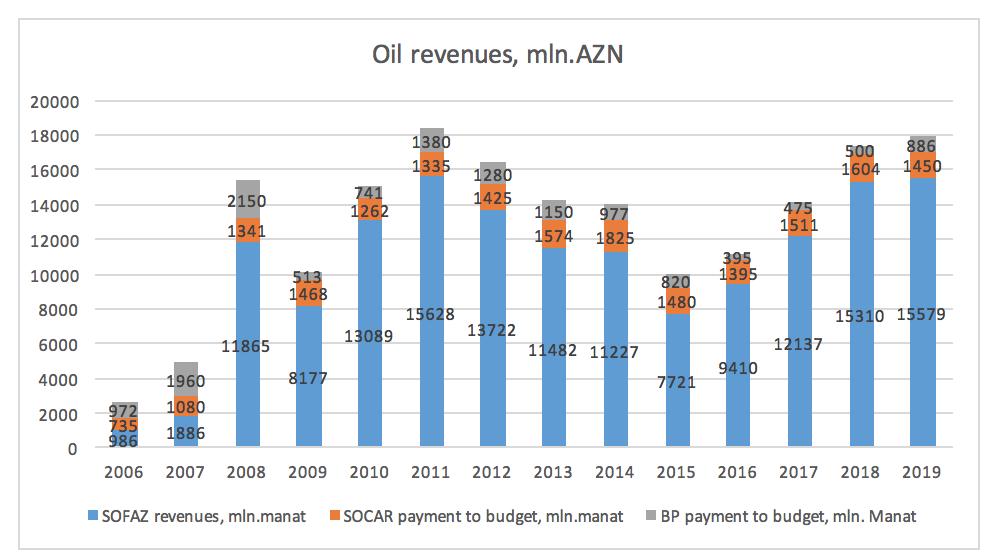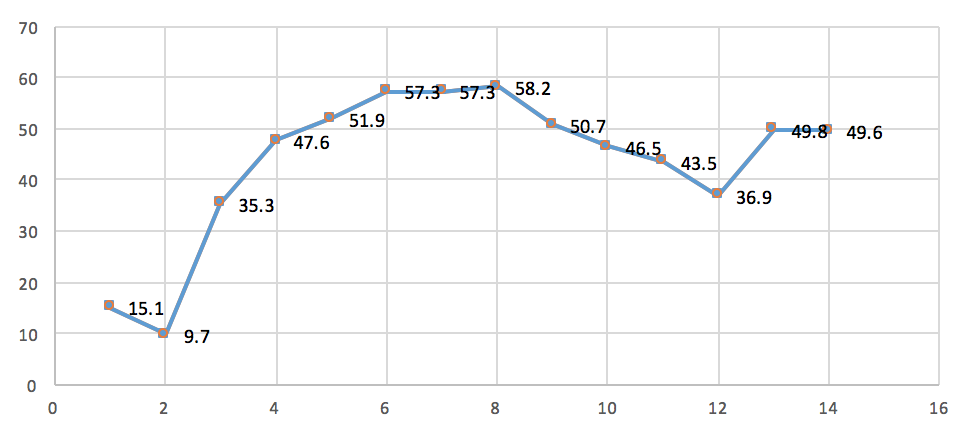About the Author: Gubad Ibadoghlu, Senior Policy Analyst for social and economic studies at Azerbaijan’s Economic Research Center, a Baku-based NGO that promotes economic development and good governance.
You may have heard of the term rentier state. It means that state budget of a resource-rich country comprises mostly of oil revenues, not taxpayer money or for-profit companies. The term has been used to describe Arab countries during the oil boom in the 1970s.
In a rentier state, the level of influence that people have on the government is significantly reduced. The role of taxpayers in the budget process is decreased, and so is public participation. Azerbaijan spends its budget like a rentier state without observing accountability and transparency, and with no public participation.
Where does the money come from?
As of today, roughly 60% of state budget of Azerbaijan is formed through oil revenues.
The annual sum of the State Oil Fund of Azerbaijan (SOFAZ) transfer in 2019 is predicted to equal 11 billion 364 million AZN, almost 50% of the budget. With direct tax payments from The State Oil Company of Azerbaijan Republic (SOCAR) and Azerbaijan International Operating Company (AIOC), the total share of oil revenues in the budget will equal 59,1%.
The Ministry of Taxes of the Republic of Azerbaijan will contribute 31.9% of the budget, the State Customs Committee of the Republic of Azerbaijan will contribute 15.1% and only 3.9% will come from other sources. This breakdown shows how dependent the country budget is on oil revenues, and how little the country gets from other sources. Taxpayers have very little say in the budgeting.
SOFAZ is not saving for the future
The objectives of SOFAZ are to finance strategic projects for the support to socio-economic development, and to collect and save oil revenues for future generations in order to ensure cross-generation equality. Despite the fact that the strategic projects are funded without any parliamentary oversight and are not transparent, they ultimately play a positive role in economic development.
However, it seems that the government does not pay attention to fair division of oil revenues among generations. Instead of saving money and directing it to long-term development projects, spending the funds has become a priority. This has led to violation of the provisions of the Long-Term Strategy on Use of Oil and Gas Revenues,[1] which states that when the revenues from oil and gas reach their peak, at least 25% of them shall be saved.
The peak of oil and gas revenues is still a matter of dispute. According to the existing information, peak revenues were reached in 2011-2015. In 2011, 61.4%[2] of revenues were spent, this figure was 78% in 2012[3], 90.4% in 2013[4], 79.4% in 2014[5], and 118.9% in 2015[6]. SOFAZ has observed the requirement to save 25% of annual revenue only once, in 2011, and violated the Strategy during the other 4 years.
Highs and lows of the budget
Azerbaijani oil found its way to the global market in 2006 through its main export, the BTC pipeline, and significant profit started arriving to the country in 2008. From 2008 to 2017, budget revenues of SOFAZ comprised 125.089 billion USD total, averaging at 13. 898 billion USD annually if we account for the exchange rates[7]. This equals predicted expenditure of the state budget of Azerbaijan in 2019.
As the oil prices dropped and the Manat was devalued by 34% in February 2015 and by 48% in December 2015, 2015 SOFAZ revenue in dollars had decreased 3 fold compared with the previous year, amounting to 4.951 billion USD[8]. In 2016, AZN exchange rate decreased to its historic low[9] and since the oil prices on the global market remained the same, budget revenue of SOFAZ in 2016 was 5.223 million USD. Increase of oil prices, along with stabilization of AZN exchange rate[10] led to increase of budget revenue of SOFAZ to 7.127 billion USD in 2017. Thus, from 2008-2017 the revenue of SOFAZ totaled at 125.089 million USD. During this period, the peak of annual revenue of SOFAZ was in 2011, when it was 19. 893 billion USD[11].
In 2018, predicted revenue of up to date budget of SOFAZ was 9 billion USD, while in 2019 it is expected to be 9 billion 164 million USD. Generally, the oil revenue of Azerbaijan in 2006-2019 can be viewed in the following graph.

As of 1 October 2018[12], SOFAZ transferred 90 billion 487 million USD dollars to the state budget. According to calculations, every 2 dollars from 3 dollars of oil revenues of SOFAZ was transferred to the budget and spent between October 2016-2018.
We can observe the portion of SOFAZ transfers in the state budget revenues in the following graph.

Two trends are visible in oil revenue management in Azerbaijan. First, in order not to overspend revenues from selling of oil, the funds are used to form state budget revenues. Second, budget expenditure has a pro-cyclic character: when revenues increase, expenditure increases, when revenue decreases, expenditure decreases too.
This analysis shows that state budget revenues
in Azerbaijan mainly emerge through rentier payments, with minimal taxpayers’
involvement and oversight.
[1] http://www.e-qanun.az/framework/6336
[2] https://www.oilfund.az/report-and-statistics/budget-information/12
[3] https://www.oilfund.az/report-and-statistics/budget-information/15
[4] https://www.oilfund.az/report-and-statistics/budget-information/8
[5] http://caspianbarrel.org/az/2015/06/dovl-t-neft-fondunun-2014-cu-il-budc-sinin-icrasi-t-sdiq-edildi/
[6] https://www.oilfund.az/report-and-statistics/budget-information/3
[7] The average exchange rate of 2008-2014, 0,78 AZN = 1 USD is taken as a benchmark.
[8] This calculation was made based on the annual average exchange rate of 1.5593 AZN= 1 USD.
[9] In 2016 the average exchange rate was 1.8016 AZN = 1 USD.
[10] In 2017 the average exchange rate was 1.7029 AZN = 1 USD.
[11] This calculation was based on the average exchange rate of 0.7856 AZN = 1 USD.
[12] https://www.oilfund.az/en/report-and-statistics/recent-figures

